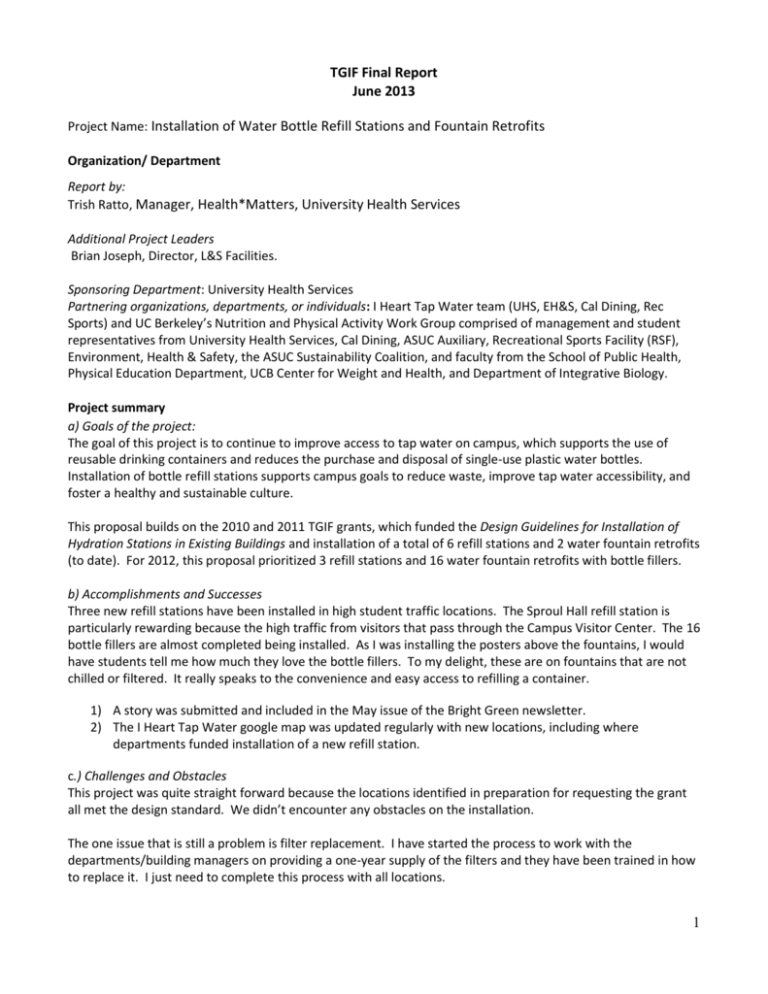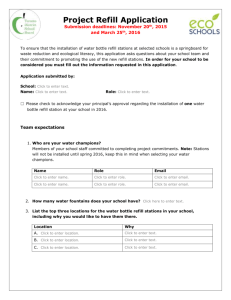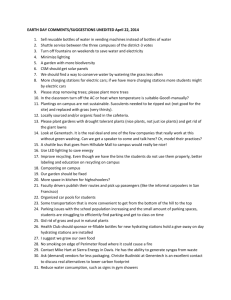Final Report - The Green Initiative Fund
advertisement

TGIF Final Report June 2013 Project Name: Installation of Water Bottle Refill Stations and Fountain Retrofits Organization/ Department Report by: Trish Ratto, Manager, Health*Matters, University Health Services Additional Project Leaders Brian Joseph, Director, L&S Facilities. Sponsoring Department: University Health Services Partnering organizations, departments, or individuals: I Heart Tap Water team (UHS, EH&S, Cal Dining, Rec Sports) and UC Berkeley’s Nutrition and Physical Activity Work Group comprised of management and student representatives from University Health Services, Cal Dining, ASUC Auxiliary, Recreational Sports Facility (RSF), Environment, Health & Safety, the ASUC Sustainability Coalition, and faculty from the School of Public Health, Physical Education Department, UCB Center for Weight and Health, and Department of Integrative Biology. Project summary a) Goals of the project: The goal of this project is to continue to improve access to tap water on campus, which supports the use of reusable drinking containers and reduces the purchase and disposal of single-use plastic water bottles. Installation of bottle refill stations supports campus goals to reduce waste, improve tap water accessibility, and foster a healthy and sustainable culture. This proposal builds on the 2010 and 2011 TGIF grants, which funded the Design Guidelines for Installation of Hydration Stations in Existing Buildings and installation of a total of 6 refill stations and 2 water fountain retrofits (to date). For 2012, this proposal prioritized 3 refill stations and 16 water fountain retrofits with bottle fillers. b) Accomplishments and Successes Three new refill stations have been installed in high student traffic locations. The Sproul Hall refill station is particularly rewarding because the high traffic from visitors that pass through the Campus Visitor Center. The 16 bottle fillers are almost completed being installed. As I was installing the posters above the fountains, I would have students tell me how much they love the bottle fillers. To my delight, these are on fountains that are not chilled or filtered. It really speaks to the convenience and easy access to refilling a container. 1) A story was submitted and included in the May issue of the Bright Green newsletter. 2) The I Heart Tap Water google map was updated regularly with new locations, including where departments funded installation of a new refill station. c.) Challenges and Obstacles This project was quite straight forward because the locations identified in preparation for requesting the grant all met the design standard. We didn’t encounter any obstacles on the installation. The one issue that is still a problem is filter replacement. I have started the process to work with the departments/building managers on providing a one-year supply of the filters and they have been trained in how to replace it. I just need to complete this process with all locations. 1 Some locations have filterless Elkay units, and we have not received any complaints. It is in the design standards to install filterless refill stations but the perception has been that there is a need for filters. Ideally, any future installations should follow the design guidelines and install filterless models. d) Feedback to TGIF TGIF has been very proactive and supportive of this initiative, and reporting/administrative mechanisms have been user-friendly and efficient. Katherine is wonderful! Thank you! e) Timeline The installations were later in getting started than planned. However, once the project started in Dec/Jan, Brian’s team moved along swiftly. The whole project took about 4 months. As of today, I believe there is just one additional bottle filler to be installed at Calif Hall. Sustainability Impact a) Quantitative or qualitative metrics The refill stations and bottle fillers, combined with the increasing number of students, faculty and staff that use refillable containers, have significantly reduced purchases of single-use water bottles. There will likely always be visitors or campus members that may need to purchase water, but we want that to be the exception not the norm. With the reduction in purchases of bottled water, this project has made significant impacts on waste and energy now and into the future. The refill stations count the number of bottle saved from the landfill. When it reaches around 30,000 and the filter is replaced it starts over. The Dwinelle unit has turned over at least 4 times. With all the refill stations on campus and now the bottle fillers, millions of single plastic bottles have not been added to the waste stream. b) on-going benefits Yes, we would expect the indirect cost savings from the reduction in sales of bottled water to have ongoing benefits to the total environment, as well as toward the campus’ sustainability goals and zero waste goals. Visibility / Outreach A story was submitted and included in the May issue of the Bright Green newsletter. Poster at the Sustainability Summit. I Heart Tap Water webpage – continue to promote the stories and google map. Some of the departments receiving refill stations and bottle filters sent out department-wide email communication announcing the new water filling options. Conclusions and next steps This is the last year of TGIF is funding refill stations and bottle fillers. Over the three years of this TGIF project, we have developed Design Guidelines for installation in existing buildings, promoted refill stations for new construction projects (which is happening), developed the Water Cooler Conversion Guide being used by several departments making the switch to another water option. These strategies are working to change our norms for water fountains, refill stations and water sources in departments. We plan to continue the I Heart Tap Water campaign, keeping the website with the online pledge, regular raffle drawings for IHTW water bottles (while these last), and updating the google map as we learn of new refill stations or bottle fillers being installed. We will continue to promote I Heart Tap Water through: 2 Posters/postcard/button distribution to groups such as Health Workers, New employee orientation, residence hall sustainability coordinators, Department Wellness Ambassadors, summer session and campus events. Using relationships with student sustainability groups to continue water-focused events on campus. Departments converting from Water coolers to other options. Facebook page. Cross marketing with campus partners. What is still needed is to include the I Heart Tap Water messages (bring your own bottle, Berkeley’s tap water is safe, refill station and bottle fillers all over campus) in the materials sent to incoming freshman (what to bring/not bring). Budget Summary Official ledger attached with email. As of Jun 4, 2013, I am not sure all expenses have been reported and I am still checking on this. I do believe there will be some remaining funds and I would like to finish this project by identifying if any more filters need to be purchased, if Brian should be installing a filter bypass in the original Elkay models at Dwinelle or Evans, and if there is any other wrap-up work to be done. I need sometime this summer to complete this. Thank you for your patience. 3 Appendix: Outreach Materials and Photos (also sent as separate files) A. I Heart Tap Water Campus Locator Google Map https://maps.google.com/maps/ms?ie=UTF8&hl=en&oe=UTF8&msa=0&msid=205805806280690383974.00049be12e44b90b5f780&ll=3 7.871974,-122.259464&spn=0.008418,0.013518&z=16 B. Bright Green Newsletter, May 2013 http://sustainability.berkeley.edu/os/pages/newsletter/docs/BrightGreenNewsV40_0513.pdf 4 C. Photos Sproul Hall Refill Station with I Heart Tap Water poster in acrylic poster holder (and signage we helped make to discourage dumping of any liquids other than water). LeConte Bottle Filler and a happy student using the bottle filler 5







